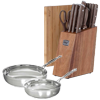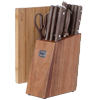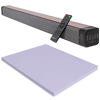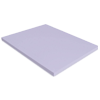How to Make Perfect Pizza Dough at Home
Welcome to Decogear.com, your ultimate resource for all things related to home cooking! In this article, we will show you how to make the perfect pizza dough from scratch. Whether you're a seasoned chef or a novice in the kitchen, our step-by-step instructions will guide you through the process of creating delicious homemade pizza dough.
From choosing the right flour to adding flavorful ingredients, stretching and shaping the dough to baking it to perfection, we've got you covered. And the best part? You can achieve outstanding results without the need for any fancy equipment or ingredients.
So, let's roll up our sleeves and dive into the world of homemade pizza dough. Get ready to impress your family and friends with mouthwatering pizzas made right in your own kitchen!

Overview: Homemade Pizza Dough
When it comes to pizza, there's nothing quite like the taste of homemade pizza dough. Not only does it allow you to customize the thickness and flavor of your crust, but it also offers a range of benefits that will make you never want to go back to store-bought dough again.
One of the biggest advantages of making your own pizza dough is the ability to control the quality of ingredients. By using fresh and high-quality ingredients, you can ensure that your dough is free from any additives or preservatives commonly found in pre-made options. This means a healthier and more flavorful crust for your homemade pizza.
Another benefit is the flexibility to experiment with different types of flour and flavors. Whether you prefer a classic white flour dough or want to try out whole wheat or gluten-free alternatives, making your own pizza dough allows you to cater to your dietary preferences and needs.
Now, let's talk about the essential ingredients for pizza dough. You'll need flour, yeast, water, salt, and olive oil. These basic ingredients come together to create the perfect dough consistency and taste. While some recipes may call for additional ingredients like sugar or herbs, these essentials are the building blocks for a delicious crust.
Ready to make your own pizza dough from scratch? Here's a simple step-by-step guide:
- In a large mixing bowl, combine the flour, yeast, and salt.
- Add the warm water and olive oil to the dry ingredients.
- Stir the mixture until it forms a shaggy dough.
- Knead the dough on a floured surface for about 5-7 minutes until it becomes smooth and elastic.
- Place the dough in a greased bowl, cover it with a clean kitchen towel, and let it rise for about an hour or until it doubles in size.
- Punch down the dough to remove any air bubbles and divide it into individual portions.
- Roll out each portion into your desired pizza shape and add your favorite toppings.
- Bake in a preheated oven at 475°F for 12-15 minutes or until the crust is golden brown and crispy.
- Enjoy your homemade pizza with your friends and family!
By following these steps, you'll be able to create a delicious homemade pizza dough that will impress everyone at your next pizza night. So why wait? Start experimenting with flavors and enjoy the satisfaction of making your own pizza dough from scratch.
Choosing the Right Flour for Pizza Dough
When it comes to making delicious homemade pizza, choosing the right flour is crucial. The type of flour you use can greatly affect the texture and taste of your pizza dough. Here are some types of flour that are suitable for pizza dough:
- All-Purpose Flour: This is a versatile option that is readily available in most grocery stores. All-purpose flour produces a chewy and tender crust, making it a popular choice for homemade pizza dough.
- Bread Flour: With its high protein content, bread flour creates a chewier and more elastic dough. It gives your pizza crust a nice structure and can withstand heavier toppings.
- Tipo 00 Flour: This Italian flour is finely ground and has a lower protein content. It results in a thin and crispy crust, perfect for traditional Neapolitan-style pizzas.
The type of flour you choose will also impact the texture of your pizza dough. All-purpose and bread flours are more forgiving and easier to work with, making them ideal for beginners. On the other hand, Tipo 00 flour requires a bit more skill to handle due to its delicate nature.
When it comes to recommended flour brands for homemade pizza dough, there are several trusted options to consider:
- King Arthur Flour: Known for its high-quality products, King Arthur Flour offers a variety of flours suitable for pizza dough.
- Caputo Flour: Caputo is a renowned Italian brand that specializes in pizza flours, including Tipo 00 flour.
- Bob's Red Mill: This brand offers a range of organic flours, including all-purpose and bread flour, perfect for homemade pizza dough.
Remember, the key to a great pizza starts with choosing the right flour. Experiment with different types and brands to find the perfect combination that suits your taste and desired pizza crust texture.
Flavoring Your Pizza Dough
Flavoring your pizza dough is a great way to elevate your homemade pizzas and create a unique taste experience. By adding herbs and spices to your dough, experimenting with different flavor combinations, and achieving a well-balanced flavor profile, you can take your pizza game to the next level.
Adding herbs and spices to enhance the flavor of your pizza dough is a simple yet effective technique. Popular choices include dried oregano, basil, garlic powder, and onion powder. These ingredients not only infuse your dough with aromatic flavors but also complement the toppings you choose. For a Mediterranean-inspired pizza, try adding a pinch of dried oregano and garlic powder to your dough.
Experimenting with different flavor combinations is a fun way to get creative with your pizza dough. You can try adding fresh herbs like rosemary or thyme, grated Parmesan cheese, or even a dash of chili flakes for a spicy kick. Don't be afraid to mix and match ingredients to find your favorite flavor profile.
When flavoring your pizza dough, it's important to achieve a well-balanced taste. Too much of a particular ingredient can overpower the overall flavor of your pizza. Start with small amounts and gradually increase as needed. Remember, you want the flavors to enhance the pizza, not overpower it.
Stretching and Shaping Pizza Dough
When it comes to making the perfect pizza, one of the most crucial steps is stretching and shaping the dough. Follow these proper techniques to ensure your pizza dough turns out just right.
To start, make sure your dough has properly proofed and risen. This will make it easier to work with and prevent it from tearing or shrinking during the stretching process.
Begin by gently pressing down the dough with your fingertips to flatten it slightly. Then, using both hands, begin to stretch the dough from the center outwards, rotating it as you go. This helps to evenly distribute the dough and prevent any air bubbles from forming.
As you stretch the dough, be mindful not to pull it too thin, as it may tear. Aim for a thickness of about 1/4 inch, or adjust according to your personal preference. Remember, practice makes perfect, so don't worry if it takes a few tries to get it just right.
To achieve the desired shape, you can either continue stretching the dough with your hands or use a rolling pin. If using a rolling pin, start from the center and roll outwards, rotating the dough as needed. This will help you achieve a round or rectangular shape, depending on your preference.
By following these techniques, you'll be able to stretch and shape your pizza dough like a pro, resulting in a delicious homemade pizza every time. Now you're ready to add your favorite toppings and bake it to perfection!

Baking Homemade Pizza
When it comes to making delicious homemade pizza, the baking process plays a crucial role in achieving the perfect crust and overall taste. In this section, we will guide you through the essential steps of baking your pizza to perfection.
Preheating the oven and preparing the baking surface are the first steps to ensure a successful pizza-making experience. Preheat your oven to the recommended temperature, usually around 450-500°F (230-260°C). This high heat will help to create a crisp crust while allowing the toppings to cook evenly. While the oven is preheating, make sure to place your pizza stone or baking sheet inside to heat up as well. This will help to transfer the heat directly to the dough, resulting in a nicely baked crust.
To achieve a crispy crust, there are a few tips and tricks you can follow. First, roll out your pizza dough to the desired thickness, keeping in mind that thinner crusts tend to be crispier. Next, brush olive oil or melted butter on the dough before adding your toppings. This will create a barrier between the sauce and the dough, preventing sogginess. Lastly, if you prefer a crisper crust, try baking your pizza directly on the pizza stone rather than a baking sheet. The stone absorbs moisture, resulting in a crispier texture.
Now, let's talk about baking times and temperatures. Every pizza recipe may vary slightly, but as a general guideline, bake your pizza for 10-15 minutes or until the crust turns golden brown and the cheese is bubbling and slightly browned. Keep an eye on your pizza while it bakes to avoid overcooking. Remember, a perfectly baked pizza will have a crispy crust with a slightly chewy texture.




















